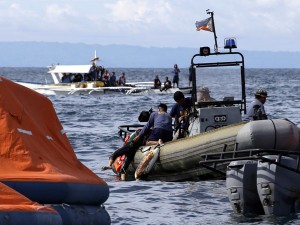Cebu ferry death toll climbs to 38, as oil leaks

Philippine Navy divers retrieve a body from the waters off the coast of Talisay city, Cebu province, in central Philippines Saturday Aug. 17, 2013, a day after a passenger ferry MV Thomas of Aquinas collided with a cargo ship Sulpicio Express Siete. AP
CEBU CITY, Philippines — Divers hauled bodies out of rough seas Sunday in the grisly aftermath of a ferry disaster that claimed at least 38 lives, as oil leaked from the submerged vessel.
Rescue efforts were focused throughout Sunday on more than 80 people missing and believed trapped inside the St. Thomas Aquinas ferry that sank on Friday night near the central city of Cebu after colliding with a cargo ship.
More than 800 passengers and crew were aboard the ferry, which sank within 10 minutes of impact.
“It is possible that there are air pockets in its compartments and there might be survivors,” Navy spokesman Lieutenant Commander Gregory Fabic told AFP, adding people could survive for 72 hours in such conditions.
“There is still hope that there might just be survivors there.”
However by nightfall the navy and coastguard divers had not been able to reach the interior of the vessel, with strong currents and choppy waves hampering efforts, and only dead bodies from its outer areas had been recovered.
The official death toll rose from 31 in the morning to 38, and authorities cautioned that the odds of finding any more survivors were low.
The military, however, said that the deaths stood at 39 as of Sunday afternoon.
“We are still hopeful, although you have to accept the reality that their chances of survival are very slim,” Neil Sanchez, head of the regional disaster management office in Cebu, told reporters.
The number of people officially listed as missing was sharply reduced on Sunday to 82 from 170, but this was due to tallying issues rather than any fresh rescues.
The number of missing was cut after those involved in the search reconciled their figures, said Sanchez.
However authorities were unable to say how many people may be in the sunken ship, which is at a depth of about 30 meters (98 feet), giving some hope the number of missing could be reduced further.
Survivors and people with relatives still missing waited anxiously at the Cebu ferry passenger terminal and a local hospital for news of loved ones.
“I cannot explain what I am feeling. It is painful, but I continue to hope,” said Nanette Condicion, 44, who survived by jumping on to the cargo ship but lost her elder sister and 71-year-old father in the chaos.
“I am staying here to wait for them, dead or alive. I am not going to leave unless I see both of them.”
Meanwhile leaking oil from the vessel added a new front to the disaster response, spreading for more than five kilometers (three miles) and into coastal villages, fishing grounds and mangroves.
“You can see it coming out of the sunken vessel. It is bunker fuel and it is black,” Cebu coastguard commander Weniel Azcuna told AFP.
At one area about five kilometers from the disaster site, mangroves were coated in black oil at low tide, and birds waded amid shallow water covered in a rainbow sheen, according to an AFP reporter.
Authorities said the ferry was carrying 120,000 liters (32,000 gallons) of bunker fuel when it sank. Divers were unable to reach the source of the leak to try and plug it.
The ships collided as they were travelling in opposite directions at a well-known choke point near the mouth of Cebu’s port.
The steel bow of the cargo ship, Sulpicio Express 7, caved in on impact but it sailed safely to dock.
Officials said they suspected human error was to blame for one of the ships going into a wrong lane, although investigations had only just begun.
Ferries are one of the main forms of transport across the archipelago of more than 7,100 islands.
But sea accidents are common, with poor safety standards and lax enforcement typically to blame.
The world’s deadliest peacetime maritime disaster occurred near the capital Manila in 1987 when a ferry laden with Christmas holidaymakers collided with a small oil tanker, killing more than 4,300 people. With Frances Mangosing, INQUIRER.net














